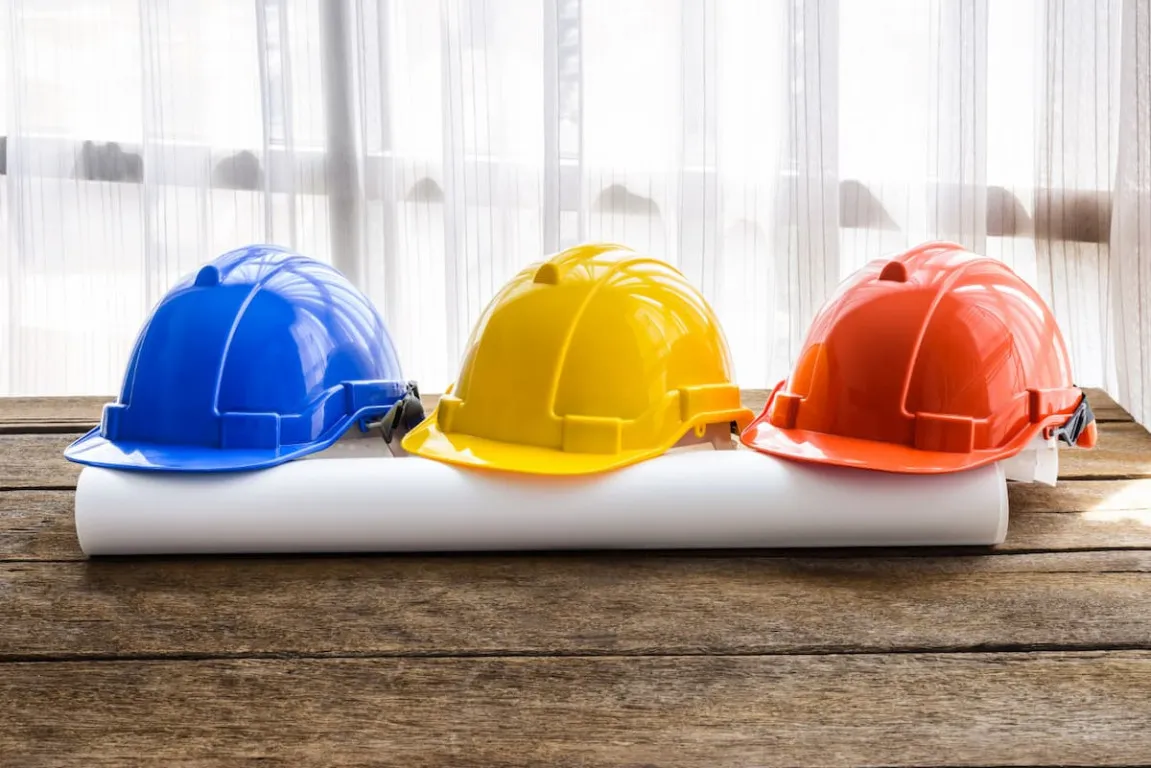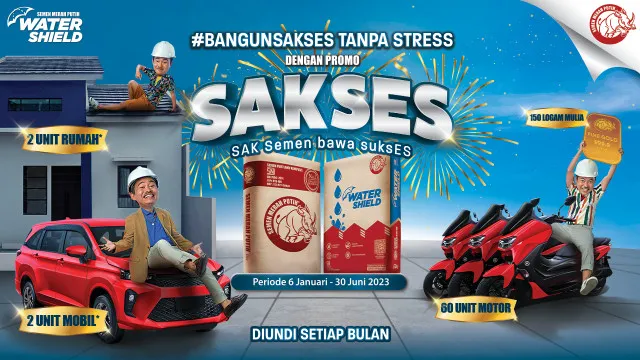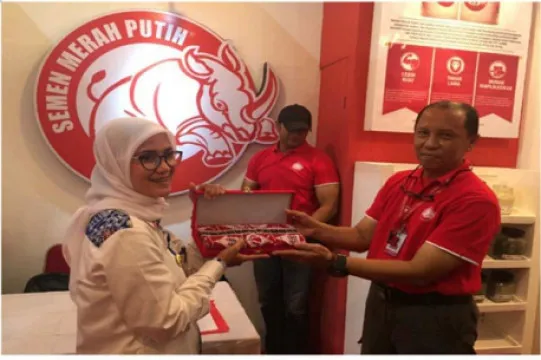A construction helmet is one of the Personal Protective Equipment (PPE) that must be used by construction project workers, especially those on a large scale. When it comes to this tool, there is one interesting fact you need to know, which is the meaning of each color.
Why are there different colors of construction helmets? Because the role of this tool is not only to protect, but also to identify positions. To be able to identify the positions of relatively many workers, construction helmets are made in several different colors.
This article will present a complete explanation of the different colors of construction helmets and their functions in general. If you want to understand it thoroughly, read this article until the end!
The Meaning of Construction Helmet Colors in Indonesia
Have you ever noticed that most construction helmets come in bright colors like yellow, red, or orange? These vibrant colors help make workers more visible on-site, reducing the risk of accidents in the project area.
Although the colors are equally striking, each color has a different meaning. Here is a complete explanation about the meaning of construction helmet colors that you need to know:
1. White Helmet
White helmets are used by workers with high positions who are experts in construction engineering, including engineers, managers, foremen, and project supervisors. This helmet color symbolizes authority, so you can ask questions related to the construction to those who wear this color helmet.
2. Yellow Helmet
Yellow helmets are worn by subcontractors and general workers. Since they handle operational work in the field, people with yellow helmets generally also wear Personal Protective Equipment (PPE), such as orange safety vests.
The choice of bright colors aims to make them visible while in the field so as to reduce the risk of work accidents.
3. Blue Helmet
Generally, people who wear blue helmets are temporary supervisors, field supervisors, or technical operators. Likewise, workers who handle heavy equipment such as bulldozers, cranes, and forklifts usually wear helmets of this color.
4. Red Helmet
In a construction environment, a red helmet reflects OHS (Occupational Safety and Health), so it is commonly used by HSE (Health, Safety, and Environment) workers. Their main task is to monitor the running of SOPs related to OHS.
5. Brown Helmet
Workers who wear brown helmets are workers who handle high-temperature work, such as welding workers or workers in smelters.
6. Green Helmet
In a general context, the color green is often synonymous with nature or the concept of “Go Green”. In the context of the construction project, it turns out that green helmets are generally worn by supervisors, researchers, environmental workers, as well as janitors.
7. Pink Helmet
While brightly colored helmets like yellow, red, or orange are typically worn by experienced workers already involved in the project, pink helmets are usually designated for new workers, interns, or students participating in Industrial Work Practices (Prakerin) at the construction site.
8. Orange Helmet
Did you know? Helmets are not only used by workers. Visiting guests are also given special orange helmets. In addition to guests, orange helmets are also commonly worn by people who inspect the construction site.
9. Gray Helmet
In addition to orange, guests may also be given gray helmets. The difference is that gray helmets are typically reserved for VIP guests and non-technical visitors, such as members of the media or investors.
This color adjustment was made because gray was considered more formal and exclusive than orange. However, this is returned to the internal policy of the company handling the project.
Read also: 10 Sustainable Building Materials for Green Constructions
The Functions of Construction Helmets
The use of helmets in construction environments serves several critical functions. Neglecting to wear one can lead to serious consequences, including injuries and financial losses. Here are some key purposes of wearing a safety helmet on a construction site:
- Protects from the head impact: Construction helmets are designed to protect the head from direct impact, impact energy from other falling objects, and similar incidents.
- Protects the head from the sun: Direct exposure to the sun on the head over a long time that trigger heatstroke. Helmets protect the head from this risk.
- Protects the head from water: Project helmets block light-intensity rainwater from hitting the head directly, although a raincoat is still needed for optimal protection.
- Protects the head from dust or dirt: By wearing a helmet, exposure to dust or dirt from above can be minimized.
- As a job identification tool: As mentioned earlier, helmet colors help indicate a worker's role or position on-site. Understanding these color codes improves coordination across different levels and streamlines the decision-making process.
- As a branding medium: Helmets can also function as a branding tool by featuring the company logo. This not only promotes brand visibility but also reinforces the company’s commitment to worker safety.
- As a form of professionalism: Wearing a safety helmet along with a proper uniform reflects discipline and responsibility. This professional appearance helps build trust and credibility with external stakeholders.
- As a communication support component: Some helmets come equipped with headsets, microphones, and Bluetooth connectivity. With these features, quick and long-distance communication can still be done smoothly.
Read also: Latest Building Material Prices, Check the Estimates!
Parts of a Project Helmet
Project helmets are designed with special parts to optimize their protective function. Some of the parts of the project helmet are:
1. Outer Shell
This part is the outermost part of the helmet, which is usually made of HDPE (High-Density Polyethylene) material so that it is strong, hard, and resistant to heat and extreme weather.
2. Brim
This part serves to protect the face from the scorching sun, rainwater, and splashes of building materials. There are two types of brim, namely full brim, which surrounds the entire helmet, and front brim, which is only on the front of the helmet.
3. Harness/Inner Suspension
The suspension is the strap and padding inside the helmet to hold and muffle the impact so that it does not hit the head directly. This allows about 1–1¼ inches of clearance between the helmet and the head.
4. Adjustment Points
This part is useful for adjusting the size of the helmet so that it is stable and fits the head. In addition to supporting safety, this part also creates user comfort.
5. Chin Strap
The chin strap feature serves to make the helmet more stable, especially when used in high-risk situations, such as work at heights. So, the chin strap is an additional feature on project construction helmets.
6. Ventilation
Some project helmets have ventilation features to keep workers' heads cool and comfortable. This feature is especially useful when the work takes place in hot weather areas.
7. Accessories
Some accessories, such as goggles, lights, face shields, and ear protection, are sometimes added to construction project helmets. The installation can be customized according to the needs of each worker.
8. Branding and Identification
Sometimes, a company logo or name is also included on the shell of the helmet. This is to identify the company or department the helmet user is from.
That is all the explanation about the meaning of construction helmet colors, functions, and parts that you need to know. Both project managers and workers must be equally committed to implementing personal protection procedures, one of which is using a project helmet.
High commitment in terms of personal protection must be accompanied by a high commitment to choosing quality materials. In a construction project, one of the materials whose role is vital is cement.
Many parts of the building are made of cement. To ensure its strength, you can rely on Semen Merah Putih Watershield, which is completed with Water Repellent Technology.
This technology provides triple protection to the building, seepage protection from 3 sources (outside, inside, and from the ground), making the building stronger, more durable, and requiring minimal maintenance. Semen Merah Putih Watershield is suitable for use in all building applications, such as foundations, concrete blocks, castings, masonry, plastering, and skim coat.
By paying attention to human aspects, such as the use of Personal Protective Equipment (PPE), and technical aspects, such as the use of high-quality cement from Semen Merah Putih, the success of construction projects can be more easily achieved.
If you want to get complete information about Semen Merah Putih products, contact us now. We are committed to providing the best construction solutions for your project.
Read also: How Building Contractors Work and the Scope of Their Field



